Tattoo Fonts: A Deep Dive into Their History, Impact, and Future
Introduction
Tattoo fonts are more than just letters etched into skin; they are a significant part of the tattooing art form. These fonts allow people to express their identities, beliefs, and emotions in a permanent way. The right tattoo font can elevate a tattoo design, adding depth, meaning, and beauty. In this comprehensive blog, we’ll explore the rich history of tattoo fonts, their positive and negative aspects, and the trends that are shaping their future. The keyword “tattoo fonts” will be a focal point, appearing throughout to provide an SEO-optimized and engaging read.


History of Tattoo Fonts
The history of tattoo fonts is as diverse and complex as the art of tattooing itself. Tattoos have been used as a form of expression for thousands of years, with evidence of tattooed individuals dating back to ancient Egypt and beyond. However, the use of specific fonts in tattoos is a more recent development, emerging as tattooing became more widespread and accepted in modern culture.
Origins of Tattoo Fonts
The earliest tattoo fonts were rudimentary, often based on simple, hand-drawn letters. These early tattoos were typically used for identification, religious rituals, or as symbols of status within a community. The fonts were influenced by the writing styles of the time, with many early tattoos featuring block letters or basic script styles.


As tattooing spread across different cultures and regions, so did the diversity of tattoo fonts. In Western culture, for example, Old English and Gothic fonts became popular during the Renaissance, reflecting the ornate and elaborate lettering styles of that era. These fonts were often used in religious texts, which made them a natural choice for tattoos with spiritual or memorial themes.
Evolution Over the Years
As the art of tattooing evolved, so too did the variety and complexity of tattoo fonts. The 20th century saw a significant shift in tattoo culture, with the rise of tattoo parlors and professional tattoo artists. This period marked the beginning of the modern tattoo font era, where artists began to experiment with different lettering styles, combining traditional fonts with new, creative designs.
During the 1960s and 70s, the counterculture movement in the United States brought a new wave of tattoo styles, including bold, psychedelic fonts that reflected the era’s rebellious spirit. These fonts were often used in tattoos that conveyed political messages, personal freedom, or anti-establishment sentiments.
Today, tattoo fonts are incredibly diverse, ranging from classic scripts to modern, digital-inspired designs. With the advent of digital technology, artists now have access to a virtually limitless array of fonts, allowing them to create truly unique and personalized tattoos for their clients.


Popular Types of Tattoo Fonts
When it comes to choosing a tattoo font, the options are almost endless. Each font style carries its own unique aesthetic and emotional appeal, making the choice of font a crucial part of the tattoo design process. Here’s a closer look at some of the most popular types of tattoo fonts:
Script Fonts
Script fonts are among the most popular choices for tattoos, known for their elegance and fluidity. These fonts mimic the look of cursive handwriting, with each letter flowing smoothly into the next. Script fonts are ideal for tattoos that feature names, quotes, or phrases, as they add a personal and emotional touch to the design.

Old English Fonts
Old English fonts are steeped in tradition and history, making them a popular choice for memorial tattoos or designs that pay homage to heritage. These fonts are characterized by their bold, blackletter style, with sharp angles and intricate details. Old English fonts are often used in tattoos that convey a sense of strength, power, or reverence.
Gothic Fonts
Gothic fonts share some similarities with Old English fonts but tend to be even more dramatic and ornate. These fonts are perfect for tattoos that aim to make a bold statement, often associated with darker or more mysterious themes. Gothic fonts are a favorite among those who appreciate the art of tattooing for its ability to convey complex emotions and narratives.

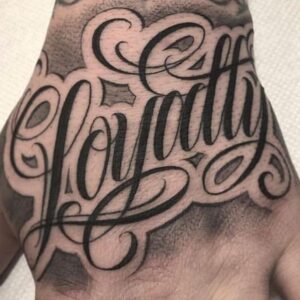
Custom and Handwritten Fonts
For those seeking something truly unique, custom and handwritten fonts offer endless possibilities. Many tattoo artists specialize in creating custom fonts that are tailored to their clients’ specific visions. These fonts can be based on a client’s handwriting or designed from scratch to match the theme and style of the tattoo. Custom fonts ensure that your tattoo is one-of-a-kind, reflecting your individuality and personal story.
Positive Aspects of Tattoo Fonts
Tattoo fonts offer a multitude of positive aspects that contribute to their enduring popularity in the tattooing world. Here are some of the key benefits:
Personal Expression
One of the most significant advantages of tattoo fonts is their ability to convey personal expression. A well-chosen font can encapsulate a person’s identity, beliefs, or emotions in a way that images alone cannot. Whether it’s a meaningful quote, a loved one’s name, or a powerful word, the right font can make the message even more impactful.

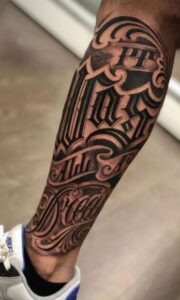
Enhancing Tattoo Designs
Tattoo fonts can elevate the overall design of a tattoo, adding layers of meaning and visual interest. When combined with other elements like imagery or symbols, the font can enhance the tattoo’s aesthetic appeal, making it more dynamic and engaging. A skilled tattoo artist can use fonts to create a harmonious balance between text and imagery, resulting in a cohesive and striking design.
Cultural and Artistic Significance
Fonts have cultural and artistic significance that extends beyond the world of tattooing. Certain fonts are associated with specific cultures, historical periods, or artistic movements, and using these fonts in tattoos can connect the design to a broader cultural or artistic context. For example, calligraphy-based fonts are often used in Japanese or Chinese tattoos, linking the artwork to traditional writing styles and cultural heritage.


Negative Aspects of Tattoo Fonts
While tattoo fonts offer many benefits, there are also some potential drawbacks to consider. It’s important to weigh these factors carefully before choosing a font for your tattoo:
Misinterpretations and Miscommunication
One of the risks associated with tattoo fonts is the potential for misinterpretation or miscommunication. Fonts that are difficult to read or too stylized can lead to confusion about the tattoo’s meaning or message. This is especially true for fonts that include elaborate flourishes or unusual letterforms, which may be visually appealing but challenging to decipher.

Limitations in Design
Not all fonts are well-suited for tattooing, especially those that are highly detailed or intricate. Small fonts with thin lines can become blurred or distorted over time as the tattoo ages, leading to a loss of clarity and legibility. Additionally, some fonts may not translate well to certain areas of the body, where the skin’s texture or movement can affect the tattoo’s appearance.
Trends That Don’t Age Well
Tattoo fonts, like any other fashion trend, can become outdated over time. A font that is popular today might not be in style a decade from now, leaving you with a tattoo that no longer feels relevant or aligned with your personal style. It’s important to choose a font that not only resonates with you in the present but also has the potential to stand the test of time.
Choosing the Right Tattoo Font
Choosing the right tattoo font is a critical step in the tattooing process. Here are some tips to help you make the best choice:
Personal Style
Your tattoo font should reflect your personal style and the message you want to convey. Consider what the font says about you and how it aligns with the overall theme of your tattoo. Whether you prefer a classic, timeless font or something more modern and edgy, the font you choose should resonate with you on a deep level.
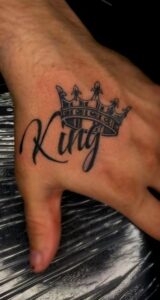

Readability
Readability is an essential factor to consider when selecting a tattoo font. The font should be easy to read, especially if your tattoo includes a longer phrase or quote. Fonts that are too stylized or intricate may look great on paper but can become difficult to read once tattooed on the skin. Opt for a font that balances aesthetic appeal with clarity.
Placement
The placement of your tattoo can greatly influence how the font appears. Different parts of the body have varying skin textures and movement, which can affect how the tattoo heals and ages. For example, fonts with fine lines may not hold up well on areas like the fingers or wrists, where the skin is subject to more wear and tear. Consider the placement of your tattoo when choosing a font to ensure the design remains clear and legible over time.
Consultation with Tattoo Artists
Always consult with your tattoo artist when choosing a font. Experienced artists can offer valuable insights and recommendations based on their knowledge of tattooing techniques and the behavior of different fonts on the skin. They can also help you visualize how the font will look once tattooed and suggest any necessary adjustments to ensure the best possible outcome.
Tattoo Fonts and Modern Technology
Modern technology has revolutionized the way tattoo fonts are created and used. Digital design tools have made it easier than ever for tattoo artists to experiment with different fonts and customize them to fit their clients’ needs. Here’s how technology has impacted tattoo fonts:

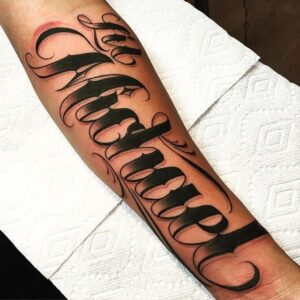
Impact of Digital Design Tools
Digital design tools allow tattoo artists to access a vast library of fonts and customize them with precision. These tools make it possible to adjust the size, spacing, and style of a font, ensuring that it fits perfectly with the overall design of the tattoo. Artists can also use digital tools to create custom fonts from scratch, giving clients a truly unique and personalized tattoo.
Access to a Wide Range of Tattoo Fonts Online
The internet has made it easier than ever for clients to explore different tattoo fonts and find inspiration for their designs. Online platforms offer access to a wide range of tattoo fonts, from classic styles to the latest trends. Websites and apps dedicated to tattoo design allow users to experiment with different fonts, preview how they will look as tattoos, and even download fonts to share with their tattoo artist. This accessibility has democratized the tattoo design process, enabling more people to take an active role in choosing the perfect font for their tattoo.
Customization and 3D Printing
Advancements in technology have also led to new possibilities in tattoo font customization. Some artists are using 3D printing technology to create stencils or molds that help ensure precise application of intricate fonts. This is especially useful for fonts that require a high level of detail or for clients who want a consistent, repeatable pattern in their tattoo. Additionally, 3D technology can be used to visualize how a tattoo will look on the body, allowing for adjustments to the font size, spacing, or placement before the tattoo is applied.

Future Trends in Tattoo Fonts
The world of tattoo fonts continues to evolve, with new trends emerging that reflect broader cultural shifts and technological advancements. Here are some trends to watch for in the coming years:
Minimalist and Micro Tattoos
Minimalism has been a growing trend in various forms of design, including tattoos. Minimalist tattoo fonts are characterized by their simplicity, using clean lines and a straightforward style. These fonts are often used in micro tattoos, which are small, delicate designs that require a font that is both legible and aesthetically pleasing at a very small scale. As the popularity of micro tattoos continues to rise, so too will the demand for minimalist tattoo fonts.
Abstract and Experimental Fonts
As tattooing becomes more recognized as a legitimate art form, artists are pushing the boundaries of what’s possible with fonts. Abstract and experimental tattoo fonts are gaining traction, offering a departure from traditional lettering styles. These fonts may incorporate elements of surrealism, geometry, or even glitch art, creating tattoos that are as much about visual impact as they are about conveying a message. This trend is particularly popular among those who see their tattoos as a form of self-expression and art.

Cultural Revival Fonts
In a world that is increasingly connected, many people are looking to their cultural roots for inspiration in their tattoos. This has led to a revival of fonts that are tied to specific cultural or historical traditions. For example, Celtic and Nordic runes, ancient Greek and Latin scripts, and traditional Chinese and Japanese calligraphy are being reinterpreted in modern tattoo designs. These fonts not only carry deep cultural significance but also allow for a fusion of traditional and contemporary tattooing practices.
Tech-Influenced and Cyberpunk Fonts
The influence of technology on art and design is undeniable, and tattoo fonts are no exception. As we move further into the digital age, we’re seeing the emergence of tech-influenced fonts that reflect the aesthetics of the cyberpunk genre and digital culture. These fonts may mimic the look of pixelated text, circuit boards, or futuristic digital interfaces. They are perfect for those who want a tattoo that feels modern and aligned with the technological era.
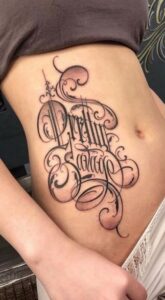
3D and Hyper-Realistic Fonts
With advancements in tattooing techniques, 3D and hyper-realistic tattoo fonts are becoming more feasible and popular. These fonts can create the illusion of depth and texture, making the tattoo appear as though it’s popping off the skin or embedded into it. This trend requires a high level of skill from the tattoo artist, as it involves intricate shading and perspective work, but the results can be truly stunning.
Considerations for Choosing a Tattoo Font
As exciting as these trends are, it’s essential to consider some practical aspects when choosing a tattoo font:
Longevity and Maintenance
Tattoos are a permanent form of body art, so it’s crucial to choose a font that will stand the test of time, both aesthetically and physically. Some fonts may look great when first tattooed but may not age well due to the natural changes in the skin or the fading of ink over time. It’s important to consider how the font will look in the long run and whether it’s easy to maintain. Regular touch-ups may be necessary to keep intricate fonts looking their best.
Placement and Size
The placement and size of your tattoo will significantly impact how the font appears. Certain fonts work better in specific areas of the body. For instance, smaller, more intricate fonts may be best suited for areas where the skin is tight and less prone to stretching, such as the forearm or upper back. Conversely, bolder fonts may be better for larger areas like the chest or thigh, where they can make a more significant impact.
Personal and Cultural Significance
While trends can be enticing, it’s essential to choose a tattoo font that has personal meaning and significance to you. Consider what the font represents and how it aligns with your personal story, values, and beliefs. Additionally, if you’re choosing a font that has cultural significance, it’s important to be respectful of that culture and understand the meanings and connotations associated with the font.

Collaboration with Your Tattoo Artist
Your tattoo artist is a valuable resource when it comes to choosing the right font. They can offer insights into how different fonts will look and behave on the skin, and they can help you customize a font to suit your needs. Don’t hesitate to ask for their professional opinion and collaborate with them to create a design that you’ll be proud of for years to come.